人教版九年级英语Unit1-8教学反思
人教版英语九年级Unit8《ItmustbelongtoCarla.》全单元说课稿

人教版英语九年级Unit 8《It must belong to Carla.》全单元说课稿一. 教材分析人教版英语九年级Unit 8《It must belong to Carla.》全单元主要围绕“推理判断”这一主题展开。
通过本单元的学习,学生能够掌握一般现在时、一般过去时和一般将来时的被动语态,以及情态动词must的用法。
教材通过丰富的情境和真实的例子,帮助学生学会如何根据线索进行推理判断,并能在实际情境中运用所学知识进行交际。
二. 学情分析九年级的学生已经具备了一定的英语基础,能够理解和运用一般现在时、一般过去时和一般将来时的被动语态。
然而,学生在情态动词must的用法上可能还存在一定的困惑。
因此,在教学过程中,教师需要关注学生的实际情况,针对性地进行讲解和练习。
三. 说教学目标1.知识目标:学生能够掌握一般现在时、一般过去时和一般将来时的被动语态,理解情态动词must的用法。
2.能力目标:学生能够在实际情境中运用所学知识进行交际,提高推理判断能力。
3.情感目标:培养学生热爱生活,关心他人的品质。
四. 说教学重难点1.重点:一般现在时、一般过去时和一般将来时的被动语态,情态动词must的用法。
2.难点:情态动词must在实际情境中的运用。
五. 说教学方法与手段1.教学方法:采用情境教学法、交际法、任务型教学法等。
2.教学手段:多媒体课件、实物、图片、卡片等。
六. 说教学过程1.引入:通过展示一张照片,让学生猜测照片中的人是谁,引出本课主题。
2.呈现:展示教材图片,引导学生观察并找出图片中的线索,推理判断出物品的主人。
3.讲解:讲解一般现在时、一般过去时和一般将来时的被动语态,情态动词must的用法。
4.练习:学生分组进行角色扮演,运用所学知识进行交际。
5.巩固:学生完成教材练习题,检测所学知识。
6.拓展:引导学生运用所学知识,谈论现实生活中的人和事。
七. 说板书设计板书设计需突出本课重点内容,包括一般现在时、一般过去时和一般将来时的被动语态,以及情态动词must的用法。
人教版英语九年级全册Unit8SectionA1(1a2d)说课稿
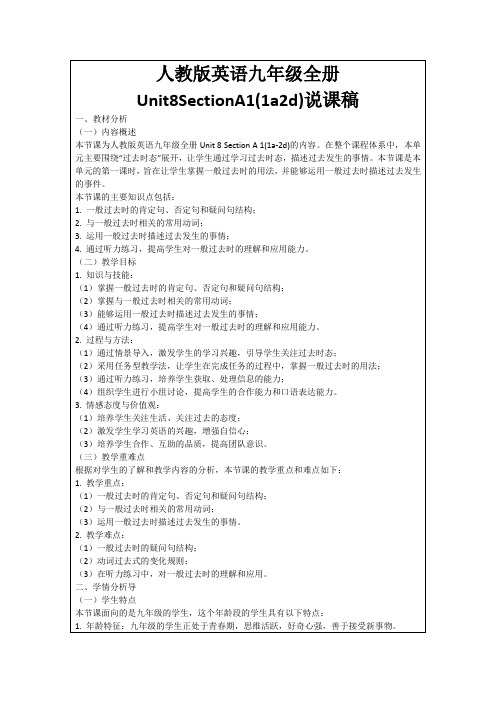
2.丰富教学手段,提高学生的学习兴趣和参与度;
3.提供丰富的语言输入,帮助学生理解和巩固语言知识;
4.促进师生互动和生生互动,提高课堂氛围。
(三)互动方式
我计划设计以下师生互动和生生互动环节,以促进学生的参与和合作:
1.师生互动:
(1)教师提问,学生回答,教师给予及时反馈和指导;
本节课的主要知识点包括:
1.一般过去时的肯定句、否定句和疑问句结构;
2.与一般过去时相关的常用动词;
3.运用一般过去时描述过去发生的事情;
4.通过听力练习,提高学生对一般过去时的理解和应用能力。
(二)教学目标
1.知识与技能:
(1)掌握一般过去时的肯定句、否定句和疑问句结构;
(2)掌握与一般过去时相关的常用动词;
1.年龄特征:九年级的学生正处于青春期,思维活跃,好奇心强,善于接受新事物。
2.认知水平:经过前两年的英语学习,学生已经具备一定的英语基础,掌握了一定的词汇和语法知识,能够进行简单的英语交流。
3.学习兴趣:学生对英语学习兴趣浓厚,尤其对有趣的故事、情境和游戏等活动感兴趣。
4.学习习惯:学生已经养成了良好的学习习惯,如按时完成作业、积极参与课堂活动等。
(二)学习障碍
1.前置知识:在学习本节课之前,学生已经掌握了现在时态、一般将来时等时态,但可能对一般过去时的用法掌握不够熟练。
2.学习障碍:学生在学习一般过去时可能存在的障碍有:
(1)动词过去式的变化规则,如不规则动词的过去式;
(2)一般过去时疑问句的构成;
(3)在具体语境中,如何运用一般过去时描述过去发生的事情。
(二)新知讲授
在新知讲授阶段,我将逐步呈现知识点,引导学生深入理解:
中考英语一轮复习 九年级Unit1 复习教案

九年级英语U1复习教学设计一、教材分析本部分内容来自人教版九年级上册,对Unit1的基础知识进行进一步的巩固与复习。
本单元的主要话题是谈论学习方法,学习对如何学习进行问答。
这部分内容与学生的学习生活紧密结合,能够让学生充分的在实践中练习运用,激发学生的兴趣,提高学生的语言运用能力。
该教材从学生的已有知识水平与心理特征出发,以《新课程标准》为依据,复习过程由浅入深,循序渐进,具体设计如下:1.对基础单词的复习,掌握重点单词以及句型,为接下来知识点的复习奠定知识基础。
2.以课本编排为线索,拓展相关知识,结合课本基础知识与课文,改编综合运用题目,直击考点,与中考题型接轨。
3.以《中考档案》为依据,对高频考点进一步讲解,辨析难点、混淆点,并以图表、例题来进一步巩固练习。
4.巩固落实语法点,为专题复习打好基础。
5.设计随堂检测部分。
针对基础知识和学生的薄弱环节设计了综合填空A的练习,重在练习学生对时态的掌握。
6.最后一个环节是能力提升环节。
写作一直是学生的短板,学生惧怕写作,是因为不知道写什么,不知道该怎样写,所以在最后一个环节特别给学生设计了一个句型积累和范文欣赏环节,为学生的写作提供支持。
二、学情分析九年级的学生在中考复习中已经具备了一定的知识基础,如何将初中所学英语知识进行前后联系,形成完整的知识体系,更好的做好基础知识储备,为中考英语基础题目部分奠定基础是复习的一个重要目的。
此外,大部分九年级学生由于平时忙于赶进度,忽视且缺乏写作能力的训练,导致很多学生一遇到作文自动跳过,所以在真正写作时苦于不会表达,无写作素材、技巧和策略,错句连篇,单纯为凑字数而凑字数。
因此,在一轮复习时,要适当穿插写作练习,不能光寄希望于专题训练。
根据复习进度,根据单元相关话题,进行写作训练。
因为课堂时间有限,所以课堂上主要给学生提供可支撑写作的相关词汇和句型的积累、范文的背诵、写作技巧的指导等,帮助学生克服写作恐惧感,而写作练习主要是让学生课后完成,然后老师批阅。
人教版九年级英语上册教案(Unit1-10单元)

中(小)学教师统一备课用纸科目English 年级Grade 9 班级C25、26 时间10年8月27日课题Unit 1 Ho w d o y o u s t u d y f o r a t e s t?The first period教学目标1.New words and expressions:flashcard, vocabulary, aloud, pronunciation,2.Talk about “How to study.”3.Learn to use “by doing”教材分析Section A 1a, 1b, 1c, 2a, 2b, 2cKey points: How do you study for a test?I study by working with friends. Difficulties: It‟s too hard to understand the voices.实施教学过程设计I. GreetingGood morning, class. Nice to see you.II. Presentation1.T: How do you go /come / get to school?S: I go / come / get to school by busby trainon foot2.Look at 1aHow do you study for a test?I study by working with friends.by making flashcardsby reading the textbook.4. 1b. Listen and write letters from the pictures above.Mei studies by flashcards.Pierre studies by asking the teacher for help.Antonio studies by listening to the tapes.5. 1c. PairworkS a: How do you study for a test?S b: I study by working with a group.Ask the students to practice in pairs.Ask some pairs to act out.III. Presentation1. 2a Listen and check the questions you hear.1√ 2√ 4√ 5√2. 2b. Listen again and match each question above with an answer below.1 d2 b 4 c 5 a3. 2c. Pairwork Make conversationsA: Have you ever studied with a group?B: Yes, I have, I‟ve learned a lot that way.Ask some pairs to act out.IV. Explain the key points and difficulties.1.what about①征求或建议What about going to the park?②劝人吃或喝What about some more milk?③询问经过或情况What about the friend you saw last year?2.way①表“道路,路线,路途”Could you please show me the way to the zoo?We go this way, you go that way.②表“方法,手段”Meat can be cooked in different ways.They are trying to find a way of solving the problem.3.by①在附近,靠近,同nearThere‟s a teacher standing by the teacher‟s desk.②经过He walked by his friends saying hello to them.③不迟于,到…为止How many songs had he learned by the end of last year.④被,由The writer was killed by a young man.⑤用,通过(方法,手段)My father goes to work by bike every day.V. Grammar FocusHow do you study for a test? I study by listening to tapes.How do you learn English? I learn by studying with a group.Do you learn English by reading aloud? Yes, I do.HomeworkMake sentences using “by + doing”教学反思中(小)学教师统一备课用纸科目English 年级Grade 9 班级C25、26 时间10年8月27日课题Unit 1 Ho w d o y o u s t u d y f o r a t e s t?The second period教学目标1. New words and expressions:specific, memorize, grammar, differently, frustrate, frustrating, quickly,excited not at all, end up2. Talk about “How to study.”3. Learn to use “by doing”教材分析Section A 3a, 3b, 3c, 4. Section B 1a, 1b, 2a, 2b, 2c Key points: the best ways of learning Englishby doing doing sth is…Difficulties: doing sth is…实施教学过程设计I. Greeting:Good morning, class.Whose turn is it today?II. Have dictation.flashcard, vocabulary, aloud, pronunciation,How do you study for a test? I study by listening to tapes.How do you learn English? I learn by studying with a group.Do you learn English by reading aloud? Yes, I do.III. RevisionHow do you study for a test? I study by listening to tapes.How do you learn English? I learn by studying with a group.Do you learn English by reading aloud? Yes, I do.IV. 1. 3a:Read the article and complete the chart.① New works and phrasesdifferently, quickly,excitedspecific, memorize, grammar, frustrate, frustrating,not at all, end up②Ways of learning Englishby using Englishby reading English magazinesMemorizing the words of pop songs also helped a little.Studying grammar is a great way to learn a language.Watching English movies isn‟t a bad way because he can watch the actors saythe words.Joining the English club at school was the best way to improve English.实施教学过程设计Having conversations with friends was not helpful at all.③Phrasesask about the best way to dospecific suggestions feel differentlyhave fun have conversations with…pretend to be not at allget excited end upwrite vocabulary list keep an English notebook2. 3b. PairworkA: I‟m doing a survey about learning English. Can I ask you some questions?B: SureA: Great. What‟s your name?B: Wei MingA: And how do you learn English, Ming?B: I learn by studying grammar and watching English movies.3. 4. PairworkCheck what you do to learn EnglishThen interview your partnerVI. Section B1. 1a What things are difficult for you? Read the list.Check the statements that are true for you.2. 1b What other things are difficult for you? Make a list.3. 2a listen and check the learning challenges1 √ 2√ 3√ 5√4. 2b. Listen again. Match the challenges in 2a with the solutions.a 2b 5c 1d 36. 2c PairworkA: I don‟t have a partner to practice English with.B: Maybe you should join an English language club.7. Phrasespronounce some of the words spell some English wordsspoken English make mistakes inwhat other things get…righttalk to practice speakingHomeworkCopy P5 2a and 2b教学反思中(小)学教师统一备课用纸科目English 年级Grade 9 班级C25、26 时间10年8月27日课题Unit 1 Ho w d o y o u s t u d y f o r a t e s t?The third period教学目标1. Learn 18 new words and expressions: realize, afraid, secret, term, trouble, fast2. Talk about “How to study.”3. Learn to use “by doing”教材分析Section B 3a, 3b, 4. and Self check Key points: by doing, doing sth is…Difficulties: by doing, doing sth is…实施教学过程设计I. Greeting:Good morning, class.Whose turn is it today?II. Have a dictation.differently,quickly,excitedspecific, memorize, grammar, frustrate, frustrating,not at all, end upIII. RevisionWays of learning Englishby using Englishby reading English magazinesMemorizing the words of pop songs also helped a little.Studying grammar is a great way to learn a language.Watching English movies isn‟t a bad way because he can watch the actorssay the words.Joining the English club at school was the best way to improve English.Phrases:ask about the best way to dospecific suggestions feel differentlyhave fun have conversations with…pretend to be not at allget excited end upwrite vocabulary list keep an English notebookpronounce some of the words spell some English wordsspoken English make mistakes inwhat other things get…righttalk to practice speaking.实施教学过程设计IV. Read 3a and write “T” or “F”1 F2 F3 T4 T5 F6 F7 TSome phrases:be difficult for sb be easy for sbfirst of all to begin withlater on be afraid to dolaugh at make complete sentencestake notes enjoying doingbe impressed have trouble doing3b: Write a letter telling a friend how to become a better language learner3c: Write an article about the things that have helped you most in learning another language.4. InterviewAsk three classmates about learning English.Take notes. Then tell the class about their answers.V. Self check.1. Fill in the blanks with the words given.2. Make your sentences,using fell, spell, write down, join, find3. Read notes on Xu Zheng and notes on Xu Zheng‟s essay.HomeworkUse the information to write an article about Xu Zheng教学反思Postscript:中(小)学教师统一备课用纸科目English 年级Grade 9 班级C25、26 时间10年8月27日课题Unit 1 Ho w d o y o u s t u d y f o r a t e s t?The fourth period教学目标1.Reading “How do we deal with our problems?”2. Learn 20 new words:3. Be able to know how to solve problems4. Master the three steps教材分析Key points: Three steps:1.Before you read2.While you read3.After you readDifficulties: deal with, unless, regard…as… duty, easily, influence, be angry with, go by friendship, lose, try one‟s best, soldier, break off实施教学过程设计1. Greeting:Good morning, class.Whose turn is it today?2. Revision.You should write down new English words in a vocabulary list.If you don‟t know how to spell new words, look them up in a dictionary.The best way to improve your English is to join English club.Another thing that he found very difficult was English grammar.This kind of paper feels very soft.3. PresentationSection 1 Before you read1a. Ask students to think of any problems they have had recently.Tell a partner how to deal with them.1b Read the title of the textAsk students to look up the meaning of each word in the box in a dictionary.Learn 20 new words.deal with, unless, regard…as… duty, easily, influence, be angry with,go by, friendship, lose, try one‟s best, soldier, break offSection 2 While you readAsk the students to read the text.2. Ask them to find outby learning to forgetby regard problems as challengesby thinking of something worseunless stay angry, see doing, decide not to talk to, an important lessonregard problems as challenges, complain about, change… into… try one‟s best compare yourself to other people with the help of our teachers实施教学过程设计4. Section 3 After you read3a. Look at the words from 1b again3b. Write out the example given for the context used in the reading.duty It is our duty to try our best to deal with each challenge in our education with the help of our teacher.smart We are probably quite healthy and smart.solve We can solve a problem by learning to forget.regard Stephen Hawking regards his many physical problems as unimportant.instead Let‟s not worry about our problem, Let‟s face the challenges instead.3c Scan the reading and check the ways of dealing with problems that are mentioned by talking to people about themby thinking your problem is not bigby breaking off a friendshipby trying to forget about themby seeing a psychologistby thinking of a problem in a positive waySection 4 Go for itWhich way of dealing with problems do you think is the best?Write about a time when you dealt with a problem this way.Homework:Write about a time when you dealt with a problem this way.教学反思中(小)学教师统一备课用纸科目English 年级Grade 9 班级C25、26 时间10年9月7日课题Unit2 I u s e d t o b e a f r a id o f t h e d a r k.The first period教学目标1. Learn the new words: used to, be interested in, be on a team2.Talk about what you used to be like.3. Be able to describe people by using “used to”4. Master “used to”教材分析Section A 1a,1b,1c, 2a,2b,2c Language Goal: Did you use to swim in the river?Yes, I did.I didn‟t use to play the piano. Difficulties: used to, on the swim team实施教学过程设计1. Greeting:Good morning, class.Whose turn is it today?2. Warming up·Write the dates on the Bb like thisSept.2, 2005 Sept. 2, 1995tall shortT: Li Ping is tall. Was he tall ten years ago?Ss: No, he was short.T: That‟s right. He was short. But now he is tall. We can describe him like thisLi Ping used to be short, but now he is tall.We use “used to ” to talk about how people or things have changed.3. Presentation①Teaching 1a·Show the chartWhat‟s the meaning of appearance and personalityAsk students to write out the words as many as possibleAppearance Personalitytall, short outgoing/easygoingstraight/curly/ hair funny, generouslong/short hair calm/wildred/blond hair smart, foolishfat/thin Serious, moodyheavy/slim·T: I used to be short. How about you?S: I used to be…T: I used to have short hair. How about you?实施教学过程设计S: I used to have….·Ask students to pract ice in pairs using “used to”②Teaching 1b·Let student look at the picture and compare the difference between two people.·Listen to the tape carefully.·Listen again and fill in the blanks③ Teaching 1c Oral practice.A: Did Mario use to be short? B: Yes, he did. Now he is tall.A: Did Mario use to wear glasses? B: Yes, he did. Now he wears contact lenses.4. Consolidation and Extension.①Teaching 2 a Look at the picture. What are they doing?Say: You will hear a boy and a girl talking to each other at a party.Some people surely changed a lot. Listen and check the words you hear.②Teacher 2bAsk the students to fill in blanks with the words they hear.Role play in pairs.③Teacher 2cPractice the conversation in activity 2b.A: I used to be really quiet.B: I know, Now you‟re very outgoing.Make conversations about yourselves.④Grammar FocusWrite the sentences on the Bb.You used to be short. He used to play tennis.Did you use to be short? Did he used to have long hair?Explain: 肯定句:S + used to be / do疑问句:Did …use to be / do…?HomeworkMake a conversation using “used to be / do”教学反思中(小)学教师统一备课用纸科目English 年级Grade 9 班级C25、26 时间10年9月7日课题Unit2 I u s e d t o b e a f r a id o f t h e d a r k.The second period教学目标1. Learn the new words: airplane, terrify, be terrified of, go to sleep, on2. Be able to talk about things in the past and now by using “used to be afraid of…”3. Foster the students‟ ability to use the language4. Be able to finish some simple tasks教材分析Section A 3a, 3b, 4 Language Goal: I used to afraid of the dark.Now I‟m still afraid of the dark. Difficulties: I‟m terrified of the dark.I go to sleep with my bed room light on.实施教学过程设计1. Greeting:Good morning, class. Whose turn is it today?2. Warming up·Show some picturesLook at the pictures and talk about them.The man used to have long hair, but now he has short hair.He used to be shy, now he is outgoing.The woman used to be fat, now she is thin.Li Lianjie used to a monk, now he is a movie star.3. Presentation①Teaching 3athe dark, snakes, big dogs, high places, being alone, flying in an airplane speaking in front of a groupT: Did you use to be afraid of the dark?being alonesnakesbig dogs,high placesflying in an airplanespeaking in front of a groupS: Yes.T: Are you still afraid of the dark? S: No, I‟m not.T: Sa used to be afraid of the dark, now he isn't.实施教学过程设计Sb used to be afraid of high places, now he is still afraid of high places.Ask the students to talk to each other.②Teaching 3bAsk a pair of students to act out.S1: I used to be afraid of snakes, now I‟m still afraid of snakes.My partner used to be afraid of being alone, now he isn‟t.S2: I used to be afraid of being alone, now I‟m not.My partner used to be afraid of snakes, now he is still afraid of snakes.Let‟s check:T: Who used to be afraid of the dark? Raise your hands. 5being alone 10snakes 12big dogs, 7high places 3flying in an airplane 2speaking in front of a group 154. Consolidation and ExtensionWhat did you use to do when your were younger?What do you do now. Fill in the chart.Then talk about how you have changed with your classmates.I used to eat chocolate, now I like to eat fruits.I think fruits are rich in vitamin and is good for health.Ask students to finish the task in the group of four.Then ask some to report.e.g. My desk mate used to eat lots of chocolate, now she likes to eat fruits.She thinks keeping fit is important.Ask students to say the information as much as possible.5. Explain①I used to be afraid of speaking in front of a group.There are a lot of trees and flowers in front of the house.Mrs Wang is standing in / at the front of the classroom.②I go to sleep with my bedroom light on.He has finished his work very well with his mother helping him.With so much work to do, my mother will be as busy as a bee. (因为)With the windows broken, this room is very cold.With a smile on his face, our English teacher came into the classroom as usual.With so many trees and flowers around, the classroom looks beautiful. Homework: Make a survey What did your family use to be afraid of?教学反思中(小)学教师统一备课用纸科目English 年级Grade 9 班级C25、26 时间10年9月7日课题Unit2 I u s e d t o b e a f r a id o f t h e d a r k.The third period教学目标1. Learn the new words: insect, candy, chew, gum, spiders2. Be able to talk about things in the past and now by using “used to …”3. Foster the students‟ ability to use the language4. Be able to finish some simple tasks教材分析Section B. 1a,1b, 2a,2b,2c Language Goal: I didn‟t use to lie tests.I used to hate gym class. Difficulties: I didn‟t use to lie tests.I used to hate gym class.I used to be on the soccer team.实施教学过程设计1. Greeting:Good morning, class.Whose turn is it today?2. Warming upUse the sentence structure: My grandpa used to be afraid of ….Ask some students to report what their family used to be afraid of.3. Presentation①Teaching 1aLook at the pictures. Ask students to describe them.S1: A girl is exercising in gym class in picture 1.S2: A girl is paining a picture in picture 2.S3: Students are singing in music class in picture 3.S4: A boy is looking at spiders and other insects in picture 4.Ask students to check the things they used to like when they were a child.②Teaching 1b PairworkWhat other things did you use to like to do when you were a child?Write sentences in the box above.Then discuss them with a partner.③Teaching 2aListen and check the sentences you hear.I didn‟t use to like tests.We used to walk to school.I used to hate gym class.④Teaching 2a实施教学过程设计Listen again.What do the girl and the boy say about things in the past and now?Fill in the chart.4. Consolidation and Extension①Teaching 2cCompare yourself with your partner.Ask two students to read the dialogue.A: I used to eat candy all the time. Did you?B: Yes, I did. And I used to chew gum a lot.Ask students to make conversations.Sa: I used to be afraid of the nurse. Did you?Sb: Yes, I did.Sc: I used to be afraid of speaking in front of the class. Did you?Sd: Yes, I did. Now I am not afraid of that.②Practice in groups.Name Habits (bite my fingernail, drink much milk…)Used to StillTomMaryHomework:Make at least five sentences using “used to…”教学反思中(小)学教师统一备课用纸科目English 年级Grade 9 班级C25、26 时间10年9月7日课题Unit2 I u s e d t o b e a f r a id o f t h e d a r k.The fourth period教学目标1. Learn the new words: chat, daily comic2. Be able to read the text fluently.3. Foster the students‟ ability to read the language4. Be able to finish some simple tasks教材分析Section B 3a,3b,3c 4, Self check 1. 2Language Goal: These days, I get up early and stay in school all day.Then I go right home and eat dinner.Difficulties: I used to spend a lot time playing games with my friends, but I just don't have the time anymore.These days I hardly ever have time for concerts.实施教学过程设计1. Greeting:Good morning, class.Whose turn is it today?2. Warming up①Teaching 3aAsk the students to answer the following questions.1. What are your biggest problems?2. Are you busy these days?3. Do you have time to play games? Why or why not?4. How often do you watch TV?Ask a student to read the text.Let students follow the tapeRead again and complete the chart.Rose Tang then Rose Tang nowhas so much time gets up early and stay in school all day spent a lot of time playing…has no time for playing gameswatched TV or chat with…has to studywent to concert with her father has no time for concertdoes homework and goes to bed3. Presentation①Teaching 3bComplete this letter.Use the information from the chart in activity 2b.didn‟t use to, used to hate…, basketball, I play football, used to walk, ride my bike②Teaching 3cAsk the students to write about how their life has changed since primary school.Begin with: My life has changed a lot since primary school….实施教学过程设计③Teaching 4a.Explain: What did your parents use to do when they were children?How is it different from what you do?Talk to your parents and fill in the chart.e.g. T: What kinds of books do you like reading, Meimei?M: I like reading comics.T: How about music?M: I like listening to pop music.T: What sports do you like best?M: I like tennis bestAsk students to fill in the chart.I…My parents used to…booksmusicsportsfoodfavorite subject at schoolfavorite things④Teaching 4bGroupworkPractice in the group of four.Talk about you and your parents with your classmates.4. Consolidation and Extension①Self check 1Ask a student to read the words.Ask students to fill in each blank with the correct word given.Read the five sentences aloud.Make sentences using the words.②Self Check 2Ask the students: What can you see in the picture?Can you find the differences for every two pictures?Look at the pictures and write about Yu Mei.HomeworkWrite about yourself since primary school.:教学反思中(小)学教师统一备课用纸科目English 年级Grade 9 班级C25、26 时间10年9月7日课题Unit2 I u s e d t o b e a f r a id o f t h e d a r k.The fifth period教学目标Reading: He used to cause a lot of trouble.1. Learn 20 new words:2. Master the usage of the key words and some key phrases.3. Be able to use the learning strategy to read an article.4. Master the main idea of the article.教材分析Language Goal: afford to do, pay for, as…as one could, in the end, make a decision, to one‟s surprise, even though, no longer, take pride in pay attention to. Difficulties: how to use the information around the word or phrases you don‟t understand.实施教学过程设计1. Greeting:Good morning, class.Whose turn is it today?2. Section 1Before you read. Ask for a show of hands of students who feel their parents are there for them, are patient and listen to problems.. Divide the class into pairs.Ask them to tell their partner about a time their parents helped them with a problem.. each student should write notes (not sentences) to describe their partner‟s problems and how their parents helped.3. Section 2While you readLearning strategy. Ask students to read the passage once without stopping, for general understanding.. Suggest a second reading to confirm their ideas and build on their knowledge.As they read, ask students to raise their hand each time they come across the new word from the text. This sentence should be read out loud to the class and discussed if there is any problem understanding it.. Key points: afford to do, pay for, as…as one could, in the end, make a decision, to one‟s surprise, even though, no longer,take pride in pay attention to.4.Section 3After you read3a. This activity show the success of using contexts to predict what information is missing.实施教学过程设计. Using the first blank as an example, show the st udents the skill of identifying missing information.. The answers are 5,2,4,1,3.3b. This activity confirms students‟ understanding of the story.. Ask students to read again, including the missing sections.. Ask students if there are any words they still don‟t understand.. Ask students to complete the task.. Ask students to work in pairs to check the answers.. The answers are F, T, T, Don‟t know, F.Section 4.Go for it.4a. Ask them to think of things they used to do.Ask them to complete some examples of change to tell their group.Homework:Review what we have learned in this unit. And finish all the exercise ofthis unit.教学反思中(小)学教师统一备课用纸科目English 年级Grade 9 班级C25、26 时间10年9月12日课题Unit 3 Teenagers should be allowed to be choose their own clothes. The first period教学目标1. Learn the new words: pierce, license, silly, earring, instead of2.Talk about what you are allowed to do.3. Learn to say “agree and disagree”4. Master “should be allowed” and “should not be allowed”教材分析Section A 1a,1b,1c, 2a,2b,2cLanguage Goal: I think sixteen-year-olds should be allowed to drive.I disagree, I think sixteen is too young.Do you think thirteen-year-olds should be allowed to have part-time jobs?No, I don‟t.Difficulties: I don‟t think fifteen-year-olds should be allowed to get their ears pierced.实施教学过程设计1. Greeting:Good morning, class. Whose turn is it today?2. Warm-upT: What do you usually do after school?Can you surf the Internet at home after school?go out at nightplay basketballdrive a carhave part-time jobscan do can‟t doplay basketball surf the Internetwatch TV go out at nightride a bike drive a carclean the house have part-time jobs3. Presentation①. Introduce the new structure ----be allowed tois allowed to isn‟t allowed toplay basketball surf the Internetwatch TV go out at nightride a bike drive a carclean the house have part-time jobsSay: Tom can play basketball at home, that means he is allowed to play basketball.Mary can‟t surf the Internet at home, that means she isn‟t allowed to surf theInternet at home.Ask students to give some activities and practice.②.Teaching 1a.1. teenager, choose, pierce2. Ask a student to read the sentences in 1a实施教学过程设计Ask the other students to say “agree or disagree.”. 3. After learning “should be allowed to”, introduce “should not be allowed to”4. Help students to understand the sentences in 1a.. Ask some students to say “agree or disagree”③Teaching 1b.1. Tell students what to do: Listen and circle “T” for true or “F” for false.2. Read the sentences in 1b3.Play the recording the first time. Students only listen.Play the recording a second time.This time ask students to circle Correct the answers. T F T4. Consolidation and ExtensionTeaching 1cAsk students to what they are allowed to do and what they a ren‟t allowed to do should be allowed to should not be allowed toPhrases: too wild, too silly, too young,not serious enough, not old enough, not calm enoughA: I think teenagers should be allowed to go out with their friends.B: I agree. They are old enough. They can look after themselves well.A: I don‟t think twelve-year-olds should be allowed to get their ears pierced.B: I agree. It‟s too silly to wear earrings in the schoolA: I think students should be allowed to do homework with their friends.B: I disagree. They talk instead of doing homework..5.Teaching 2a, 2b1. Tell students what to do:Listen and circle “Agree”, “Disagree”, or “Doesn‟t know”2. Read the sentences in 2a3. Play the recording the first time. Students listen. Correct the answers.1. Disagree2. Agree3.Doesn‟t know4. Disagree5. Agree6. AgreePlay the recording a second time. This time ask students to number the reasonsin the correct order.4 1 5 2 36.Teaching2c PairworkA: Do you think teenagers should be allowed to have mobile phones?B: Yes, it‟s convenient for students and their parents to communicate with each other.A: Do you think teenagers should be allowed to have mobile phones?B: No, I don‟t think so. Perhaps students pay more attention to short messages than their studies.A: Do you think teenagers should be allowed to trip by themselves?B: Yes, I do. Students may ask some travel agencies to help them.Grammar focus: Review the grammar box.Homework Copy grammar twice教学反思。
人教版英语九年级全册Unit8SectionA3a3c说课稿

1.知识与技能目标:学生能够掌握本节课的主要词汇和语法知识,运用一般过去时描述过去的事件。
2.过程与方法目标:通过小组讨论、角色扮演等活动,提高学生的阅读理解能力和口语表达能力。
3.情感态度与价值观目标:学生能够理解并尊重父母的教育原则,学会与父母沟通,形成正确的价值观。
(三)教学重难点
(三)巩固练习
为了帮助学生巩固所学知识并提升应用能力,我计划设计以下巩固练习和实践活动:一是分组讨论,让学生围绕本节课的主题展开讨论,用英语表达自己的观点;二是角色扮演,让学生模拟课文中的场景,运用所学知识进行实际交流;三是完成课后练习,让学生在课后进一步巩固所学知识。
(四)总结反馈
在总结反馈阶段,我会引导学生进行自我评价,并提供有效的反馈和建议。首先,我会让学生回顾本节课所学的知识,总结自己的收获和不足。然后,我会根据学生的表现,给予他们积极的评价和鼓励,并提出一些改进的建议。
(三)学习动机
为了激发学生的学习兴趣和动机,我将采取以下策略或活动:一是通过引入与学生生活密切相关的话题,激发他们的学习兴趣;二是通过设置各种层次的问题,引导学生主动思考,积极参与课堂讨论;三是通过小组合作学习和角色扮演等活动,提高学生的参与度和实践能力;四是及时给予学生反馈,鼓励他们积极参与,增强他们的自信心。
三、教学方法与手段
(一)教学策略
在本节课的教学中,我将以任务型教学法为主,结合交际法和情境教学法。任务型教学法能够让学生在真实的任务中运用所学知识,提高他们的实践能力;交际法能够引导学生进行真实的交流,提高他们的口。这些方法的的理论依据是现代语言教学观,即语言学习应该以学生为中心,注重学生的实践和应用。
人教版英语九年级全册Unit8SectionA3a3c说课稿
新人教版九年级全一册英语 Unit8 第1课时 教案(教学设计)
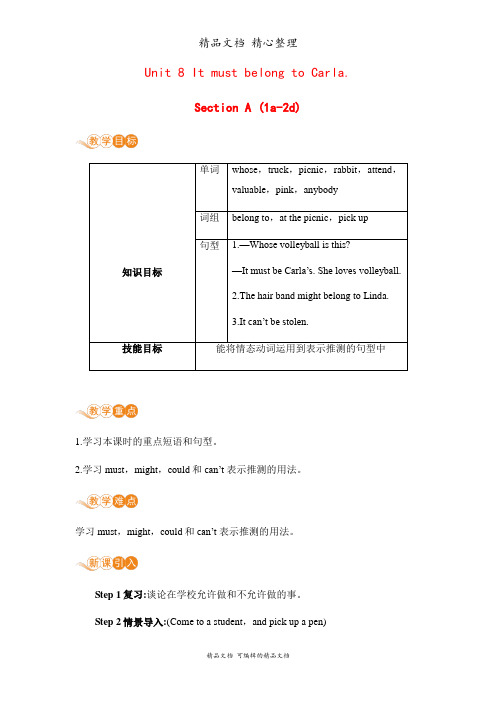
Unit 8 It must belong to Carla.Section A (1a-2d)单词whose,truck,picnic,rabbit,attend,1.学习本课时的重点短语和句型。
2.学习must,might,could和can’t 表示推测的用法。
学习must,might,could和can’t 表示推测的用法。
Step 1复习:谈论在学校允许做和不允许做的事。
Step 2情景导入:(Come to a student,and pick up a pen)T:The pen is Huang Ming’s. We can also say,“The pen belongs to Huang Ming.”Now please make sentences with your school things like this.环节说明:该环节过渡自然,介绍词组belong to的用法。
Step 3完成教材1a-1c中的任务:1.在1a表格中相应的栏目下补充更多你看到的物品。
2.听录音,根据对话内容,将1b表格中的人物、物品和原因相匹配。
3.再听一遍录音,并跟读对话。
4.两人一组练习1c中的对话,然后根据1b中的信息仿照1c的形式编新的对话。
5.小结训练根据汉语意思完成句子(1)走了这么远的路,你一定饿了。
You hungry after all that walking.(2)这个卡车玩具属于鲍勃。
The toy Bob.(3)这是谁的自行车?is this?答案:(1)must be(2)truck belongs to (3)Whose bike1.— model plane is this?—I think it’s Jim’s. Look, his name is on it.A.WhoB.WhatC.WhoseD.Where答案:C who意为“谁”;what意为“什么”;whose意为“谁的”;where意为“哪里”。
人教版九年级英语全一册Unit1第1课时教案

a. Yes, I have. I’ve learned a lot that way.
b. Oh, yes. It really improves my speaking skills.
B: I study by…
Step 6 Listening
2a,Listen and check the questions you hear.
1 ____ Does anyone learn English by watching videos?
2 ____ Do you have conversations with friends in English?
S: I study English by ______.
by working with friends.
by making word cards.
by asking the teacher for help.
by reading the textbook.
by working with a group.
Let the students read the conversation in pairs first and then discuss the difficult points
If necessary, the teacher can help the students
Then give the students a few minutes to practice the dialogue.
2. His grandfather made a living _________ (靠卖水果) in the past.
人教版英语九年级Unit1《Howcanwebecomegoodlearners》全单元说课稿
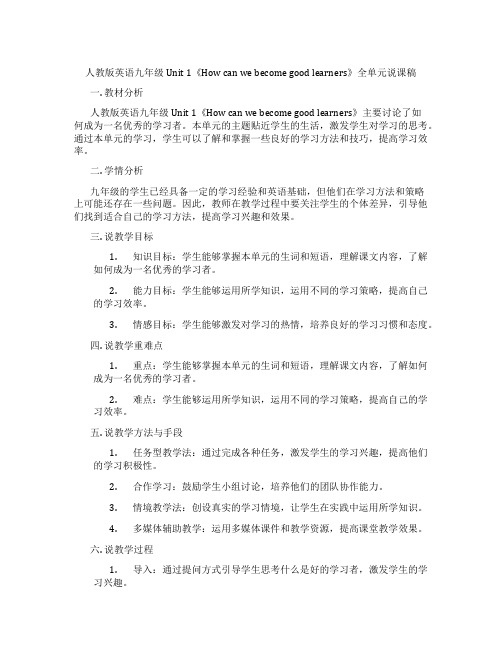
人教版英语九年级Unit 1《How can we become good learners》全单元说课稿一. 教材分析人教版英语九年级Unit 1《How can we become good learners》主要讨论了如何成为一名优秀的学习者。
本单元的主题贴近学生的生活,激发学生对学习的思考。
通过本单元的学习,学生可以了解和掌握一些良好的学习方法和技巧,提高学习效率。
二. 学情分析九年级的学生已经具备一定的学习经验和英语基础,但他们在学习方法和策略上可能还存在一些问题。
因此,教师在教学过程中要关注学生的个体差异,引导他们找到适合自己的学习方法,提高学习兴趣和效果。
三. 说教学目标1.知识目标:学生能够掌握本单元的生词和短语,理解课文内容,了解如何成为一名优秀的学习者。
2.能力目标:学生能够运用所学知识,运用不同的学习策略,提高自己的学习效率。
3.情感目标:学生能够激发对学习的热情,培养良好的学习习惯和态度。
四. 说教学重难点1.重点:学生能够掌握本单元的生词和短语,理解课文内容,了解如何成为一名优秀的学习者。
2.难点:学生能够运用所学知识,运用不同的学习策略,提高自己的学习效率。
五. 说教学方法与手段1.任务型教学法:通过完成各种任务,激发学生的学习兴趣,提高他们的学习积极性。
2.合作学习:鼓励学生小组讨论,培养他们的团队协作能力。
3.情境教学法:创设真实的学习情境,让学生在实践中运用所学知识。
4.多媒体辅助教学:运用多媒体课件和教学资源,提高课堂教学效果。
六. 说教学过程1.导入:通过提问方式引导学生思考什么是好的学习者,激发学生的学习兴趣。
2.呈现:展示课文内容,让学生整体理解课文主题。
3.读写:学生独立阅读课文,完成相关练习,巩固所学知识。
4.听说:学生分组讨论,分享自己的学习方法和策略,培养他们的口头表达能力。
5.展示:学生展示自己的学习成果,互相评价,提高自己的学习效果。
6.总结:教师对本节课的内容进行总结,强调良好的学习习惯和态度的重要性。
人教版英语九年级全册-Unit8单元教学计划
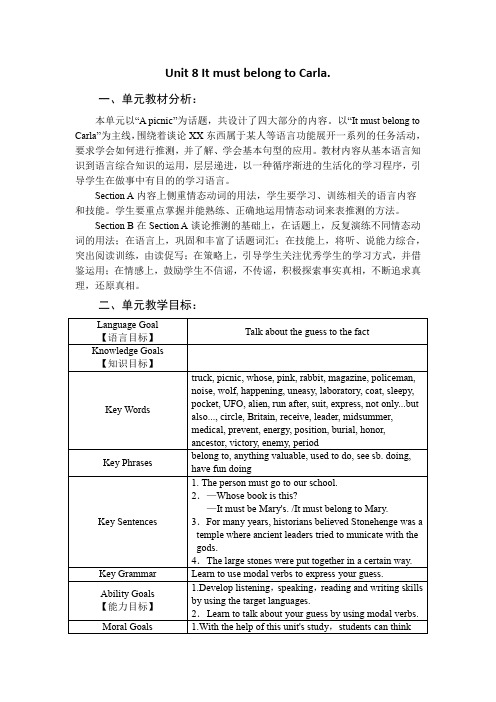
Unit 8 It must belong to Carla.一、单元教材分析:本单元以“A picnic”为话题,共设计了四大部分的内容。
以“It must belong to Carla”为主线,围绕着谈论XX东西属于某人等语言功能展开一系列的任务活动,要求学会如何进行推测,并了解、学会基本句型的应用。
教材内容从基本语言知识到语言综合知识的运用,层层递进,以一种循序渐进的生活化的学习程序,引导学生在做事中有目的的学习语言。
Section A内容上侧重情态动词的用法,学生要学习、训练相关的语言内容和技能。
学生要重点掌握并能熟练、正确地运用情态动词来表推测的方法。
Section B在Section A谈论推测的基础上,在话题上,反复演练不同情态动词的用法;在语言上,巩固和丰富了话题词汇;在技能上,将听、说能力综合,突出阅读训练,由读促写;在策略上,引导学生关注优秀学生的学习方式,并借鉴运用;在情感上,鼓励学生不信谣,不传谣,积极探索事实真相,不断追求真理,还原真相。
二、单元教学目标:三、单元教学过程与方法在课堂上引导学生掌握知识点的细节,为学生标记重点知识,并对学生之前学到的相关的知识点进行回顾和强调。
四、情感态度与价值观了解国外的文化背景,培养阅读的兴趣爱好,掌握严密的英语逻辑思维。
五、单元重点和难点:1、学会运用情态动词来表推测。
2、学会描述表示物品所属提问和回答3、阅读短文,获得相关的信息。
通过阅读练习,来提高阅读能力。
六、单元考试重点及知识拓展:(一)、辨析join/take part in/attendjoin指加入某个党派, 团体组织等, 成为其中一员, 意为“ 参军, 入党, 入团”。
e.g. join the Army/the Party/the Leaguejoin sb. in (doing) sth. 和某人一道做某事e.g. Will you join us in the picnic? 你参加我们的野炊吗?join in多指参加小规模的活动如“游戏, 比赛”, 口语中常用。
2019 秋人教版初中英语九年级全册Unit1---Unit8 重点短语,句型翻译练习题(含答案)

九年级全册Unit1---Unit8 重点短语,句型翻译练习题Unit1+Unit21.我不得不读完一本书并且在下周一做一份报告。
I have to __________________a book and___________________ next Monday2.我想学习新单词和更多的语法,这样我就可以对英文电影有一个更好的了解。
I want to earn new words and more grammar___________________ I can______________________ English movies3.但是你是否能做好这件事取决于你的学习习惯。
But_______________________________________ depends on your learning habits.4.研究表明成功的学习者有一些相同的良好习惯。
Research shows that successful learners have some good habits______________________5.他们也寻找方法复习已经学过的东西。
They also look for ways to review ______________________________________6.他们甚至相互提问并尽力找出答案。
They even ask each other and________________________________ the answers.7.我觉得我们一天吃五顿饭!我都重了五磅。
I think that we ate five meals a day! I’ve _______________________________ five pounds8.我想知道那是否和云南省傣族人的泼水节相似。
I wonder if_______________________________ the Water Festival of the Dai people in Yunnan Province9.他还赠送礼物给那些需要帮助的人。
九年级英语全册 《Unit 8 It must belong to Carla1》教案

Unit 8 It must belong to Carla〔第1课时〕一、教材分析本单元以“A picnic〞为话题设计教学内容。
以“It must belong to Carla〞为主线围绕谈论某东西属于某人等语言功能展开一系列的任务活动。
本节课主要是属于教学内容的第一局部,要求学会如何进行推测,了解、学会根本句型的应用。
教材内容从根本语言知识到语言综合知识的运用,层层递进,以一种循序渐进的生活化的学习程序,引导学生在做事中有目的的学习语言。
二、三维目标:1、知识目标:本单元通过学习情态动词,学会正确运用must, might, could和can’tbelong to与be在使用中的区别。
2、能力目标:对本单元中的生词做到会读,会写,会用,培养学生听说读写的能力和观察事物的能力。
3、情感目标:培养学生关心他人的情感。
三、教学重点1. 情态动词must,could,might和can’t表推测判断的用法。
2. belong to 短语的应用。
四、教学难点1、情态动词must,could,might和can’t表推测判断的用法。
. 2、 belong to sb 与be sb’s的区别。
五、教学策略:归纳总结情态动词can, may, must表推断的用法,比拟它们的用法区别。
在选择它们进行运用时,要多角度,全方位地思考,根据句子语境明确句子的含义,选择正确的情态动词。
六、教学准备:PPT,一些常见学习用品,录音机七、教学环节1、课堂导入1〕.猜单词,用一些常见实物(碟子、石头、书、CD等)或者用图片、单词卡让学生表达以下单词,先给一名学生看,让他用英语来描述,其他学生猜。
2〕.教学引出本课重点:must,might,could,can’t,belong to1.利用课件中的图片内容进行以下教学活动。
中的教师展示一些学生很熟悉的东西,可以有学生天天带在身边的钥匙、文具盒、笔,发带,或者是其他老师的衣服、饰物。
(人教版新目标)初中九年级英语Unit 1教学课件专题设计与总结
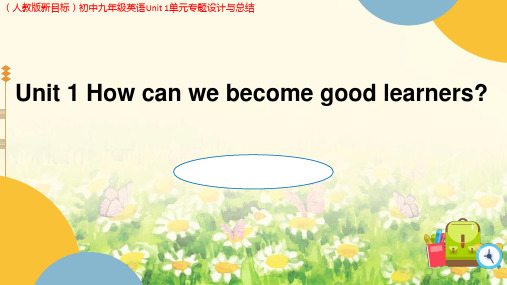
Lesson 1 听说 Lesson 2读写
内容:谈论学习英 语,为考试做准备和 写阅读报告的学习策 略。
主题意义:通过三个 小话题导出学习策 略。
内容:魏芬通过看英 文电影从而找到自 己学习英语的有效 学习策略。
主题意义:通过对 魏芬英语课堂里的 变化的描述,让读 者体会学习策略的 重要性。
聚焦能力:听力获 取信息的能力,口 语表达能力。
(人教版新目标)初中九年级英语Unit 1单元专题设计与总结
基于六要素整合 的学习活动途径
批判评价创造 分析判断内化 描述分析运用 感知获取梳理
教(人材教分版新析目标—)—初中L九e年ss级o英n语2UniHt 1单o元w专I题L设e计a与rn总e结d to Learn English(读写课)
Last year English class
Now
(人W教版h新il目e-标r)e初ad中i九n年g级(英s语cUannitn1单in元g专) 题设计与总结
描述与阐释
Task two—Answer the two questions. 1.Why did Wei Fen find it difficult to learn English? 2.What is the secret to language learning?
获取与梳理 概括与整合 (人W教版h新il目e-标r)e初ad中i九n年g级(英s语cUannitn1单in元g专) 题设计与总结
Task three— Finish 3b with the mind map.
Watching English movies
(人P教o版s新t-目r标e)ad初i中n九g年级英语Unit 1单元专题设计与总结
人教英语九年级unit8教学设计
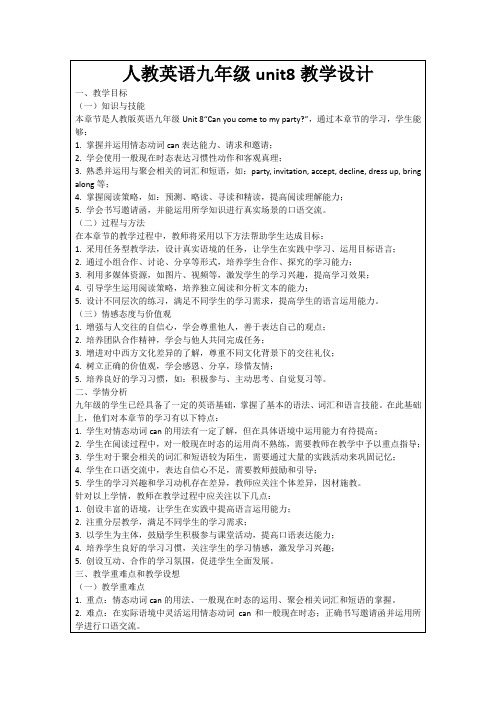
3.教师对学生的表现给予积极评价,鼓励学生在课后继续练习,提高语言运用能力。
五、作业布置
为了巩固本节课的学习内容,提高学生的语言运用能力,特布置以下作业:
1.书面作业:
-完成课后练习册中与本节课相关的练习题,重点关注情态动词can的用法和一般现在时态的运用;
-对比一般现在时态与一般过去时态的用法,让学生在实际语境中感知时态的差异。
5.创设互动、交流的平台,鼓励学生大胆开口,提高口语表达能力。
-课堂活动:组织学生进行角色扮演,模拟聚会场景,练习口语交流。
6.注重分层教学,关注个体差异,使每个学生都能在原有基础上得到提高。
-设计不同难度的练习题,满足不同层次学生的学习需求。
-根据课堂所学,编写一个聚会邀请函,要求格式规范,内容丰富,用词准确。
2.口语作业:
-与同学合作,录制一个聚会邀请和回答的对话,要求发音准确,语调自然,能熟练运用所学词汇和短语;
-观看与本节课主题相关的英语视频,模仿并练习其中的口语表达。
3.拓展作业:
-收集更多关于聚会话题的词汇和短语,了解不同文化背景下的聚会习俗;
1.创设丰富的语境,让学生在实践中提高语言运用能力;
2.注重分层教学,满足不同学生的学习需求;
3.以学生为主体,鼓励学生积极参与课堂活动,提高口语表达能力;
4.培养学生良好的学习习惯,关注学生的学习情感,激发学习兴趣;
5.创设互动、合作的学习氛围,促进学生全面发展。
三、教学重难点和教学设想
(一)教学重难点
3.增进对中西方文化差异的了解,尊重不同文化背景下的交往礼仪;
4.树立正确的价值观,学会感恩、分享,珍惜友情;
人教版初中初三九年级英语第八单元unit8教材全解加课后练习附答案(8页)备课教案教学设计教学反思导学案

导学案教师: 学生: 年级:日期: 星期: 时段:课题第Unit8 It must belong to Carla考点分析:unit8核心语法之情态动词表示推测的用法学习目标与考点分析情态动词表推测的用法;表达某人的想法与观点学习重点学习方法学习内容与过程课文解读Section BStonehenge ---- Can Anyone Explain Why It Is There?Stonehenge, a rock circle, is not only one of Britain’s most famous historical places but also one of its greatest mysteries. Every year it receives more than 750,000 visitors. People like to go to this place especially in June as they want to see the sun rising on the longest day of the year.For many years, historians believed Stonehenge was a temple where ancient leaders tried to communicate with the gods. However, historian Paul Stoker thinks this can’t be true because Stonehenge was built so many centuries ago. “The leaders arrived in England much later,” he points out.Another popular idea is that Stonehenge might be a kind of calendar. The large stones were put together in a certain way. On midsummer’s morning, the sun shines directly into the center of the stones. Other people believe the stones have a medical purpose. They think the stones can prevent illness and keep people healthy. “As you walk there, you can feel the energy from your feet moving up your body,” said one visitor. No one is sure what Stonehenge was used for, but most agree that the position of the stones must be for a special purpose. Some think it might be a burial place, or a place to honor ancestors. Others think it was built to celebrate a victory over an enemy.Stonehenge was built slowly over a long period of time. Most historians believe it must be almost 5,000 years old. One of the greatest mysteries is how it was built because the stones are so big and heavy. In2001, a group of English volunteers tried to build another Stonehenge, but th ey couldn’t. “We don’t really know who built Stonehenge,” says Paul Stoker. “And perhaps we might never know, but we do know they must have been hardworking ---- and great planners!”要点详解1.Why do you think the man is running?本句由“疑问词+do you think+其他”构成的特殊疑问句。
人教版初中初三九年级英语第八单元unit8复习课教学设计 (1)(8页)备课教案教学设计教学反思导学案

Unit 8 It must belong to Calar.复习课前案——【基础知识梳理】一、重点词汇、短语1.belong v 属于= be owned bybelong to +人名(不能用所有格)+代词宾格(不能用物主代词)属于【注】:belong to不能用于进行时态或被动形式,其主语常常是物。
Sth. belongs to sb = sth is sb’s活学即练:①The sweater belongs to __________ .( Tom) = The sweater is_______.②Tai Wang __________(属于) China.2.attend v 出席;参加attend a meeting 出席会议【辨析】join/join in/take part in/attend(1)join指加入某个党派, 团体组织等, 成为其中一员, 意为“ 参军, 入党, 入团”。
join the Army/the Party/the LeagueWill you join us in the picnic? 你参加我们的野炊吗?(2)join in多指参加小规模的活动如“游戏, 比赛”, 口语中常用。
join sb. in (doing) sth. 和某人一道做某事Join in the basketball game. 参加篮球赛。
(3)take part in 指参加群众性活动, 着重说明主语参加该项活动并在活动中发挥作用。
We’ll take part in the sports meeting/c lub.take an active part in 积极参加(part前有形容词时加不定冠词)(4)attend 正式用语vt. 指参加会议, 婚礼, 葬礼, 典礼; 去上课, 上学, 听报告等。
句子主语只是去听, 去看, 自己不一定起积极作用。
活学即练:①Some model teachers were invited __________ (attend) the meeting.② I ______________ (参加音乐会) last night. It was wonderful.3.value n 价值→ valuable adj. 贵重的;很有用的;宝贵的value v. 重视,珍视value sb. as one’s friend 将某人珍视为朋友活学即练:I think nothing else in the world is more ___________(有价值的) than my parents’ love.4.“the rest of +名词”时,谓语动词的数要与the rest of所表示的名词的数保持一致。
Unit8大单元整体教学设计人教版英语九年级全册
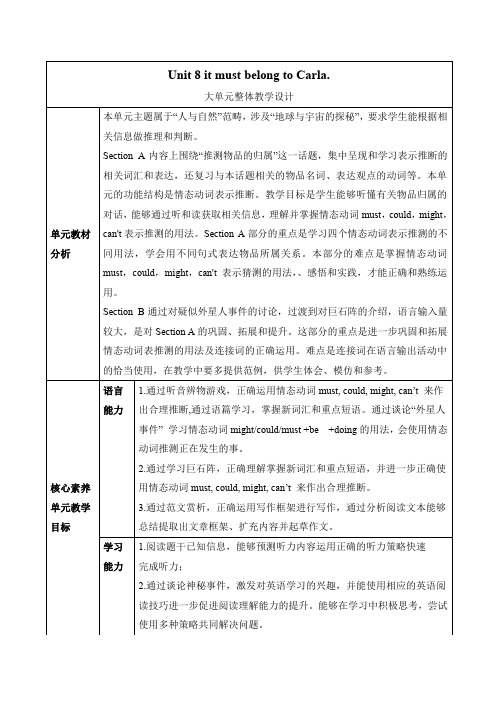
核心素养
单元教学
目标
3.通过学习英国巨石阵,培养对神秘事物的探索精神。
1.重点:
(1)重点短语和句型。
(2)运用适当的阅读策略完成相应的阅读任务。
2.难点:学会正确表示推测,并正确使用连接词。
Period ⅤSection B(3a~Self Check)
1.学习用书面语言写关于神秘事件的新闻。
2.复习本单元学习的重点词汇和语言结构。
1.学会用情态动词来推测。
2.让学生根据已有事实推测可能性。面对暂时不可解释的事情,不信谣不传谣。
1.重点:
(1)能根据上节课所学短文,完成写段落关键词及短文填空的任务。
(2)掌握本单元所学情态动词表推测的用法,并能正确运用此句型来进行表达。
(3)能综合运用就本单元所学习的语言知识来写作推测事件发展可能性。
思维
品质
1.通过听力活动练习,能精准预测并提取关键信息,锻炼思维的逻
辑推理能力。
2.通过语篇学习,进行合理推测,提升思维的逻辑性,准确获取不明事物信息。总结情态动词表推测的用法,提高思维的批判性和逻辑性。培养学生关爱社会、关爱他人的良好情操。
3.通过小组合作,能够使用所学目标语言,根据图片信息,推断故事的情节发展。提高思维的批判性和逻辑性。
3.通过连接已知经验,能够预测听力内容,听懂相关话题的简短对话,提高运用策略的意识。通过谈论未解之谜,激发对英语学习的兴趣,并能正确识别、连接词等英语阅读策略进一步提升阅读理解能力。
人教版九年级英语Unit1-8教学反思(精选五篇)

人教版九年级英语Unit1-8教学反思(精选五篇)第一篇:人教版九年级英语Unit1-8教学反思九年级英语Unit1教学反思本节重点以使用“by ”来阐述或表达做事的方法,在教学设计中我重点强调了如何用“by” 说、写,用“I go to school by bike” 导入,之后让学生discuss学习中的策略,对程度较差的学生要求能用by 说一句话,对程度较好的学生要求用“by ”表达学习方法并能表明理由。
这样做就是最大限度的为听力、阅读文章作出铺垫,而在文章的教学上首先让学生找出显在的方法句(即由“by ”引导的)和隐性的方法句(即没有“by ”引导,但仍然呈现一种方法),紧接着就是词汇的训练,将其体现在句子中,由词至句的操练,帮助学生明白意思并能掌握用法,而整个教学过程的检测体现于pair work和group work之中。
本节着重从以下几点入手1、了解个体差异,对不同程度的学生设计不同水平的问题,保证学生在原有基础上逐步提高;2、对难以启齿的学生采用鼓励的策略,尽管学生回答问题是被动的,但目的是解决又说的强压到释言的心理变更过程,使他们明白学习英语不能是心明,而更要脑清、嘴顺,善于表达个人意见;3、词汇训练这一关,突破“死记”,在“活用”方面取得进展。
九年级英语Unit 2教学反思本节课让学生学会描述自己和他人在外貌、性格、爱好等方面的变化。
学会使用used to结构来表示过去经常而现在已不存在的习惯或状态。
我在课前先让学生欣赏歌曲《Yesterday once more》,让学生在怀旧的音乐氛围中观看一些旧照片,再通过新旧照片的对比来引出本课的教学重点并复习再现了一系列描述性形容词。
通过让学生谈论自己和他人的各种变化来巩固练习used to 的用法,最后以Interview 来结束本课,希望学生能珍惜现在、展望未来。
在教学中,我发现我对used to的用法讲解的还不够透彻,在后来的学生调查活动中,我发现学生对used to的用法还没有完全掌握。
人教版九年级英语全册Unit8单元说课稿

3.定期进行教学总结,不断提高自己的教学水平。
(二)教学反思
在教学过程中,我预见到以下可能出现的问题或挑战:
1.学生对时尚词汇的掌握程度不一,可能导致课堂参与度不均;
2.现在进行时态的用法和动词形式变化容易混淆;
3.小组合作中,可能出现分工不均、沟通不畅等问题。
为应对这些问题,我将:
1.课堂上关注学生的学习反馈,适时调整教学节奏,确保学生跟上进度;
(二)教学目标
知识与技能:1.学生能够掌握与时尚相关的词汇和表达方式;2.学生能够用现在进行时描述正在进行的动作;3.学生能够了解并参与组织一场时装秀。
过程与方法:1.学生通过小组合作,提高沟通和协作能力;2.学生通过阅读和讨论,提高阅读理解和思辨能力;3.学生通过观察和实践,培养观察能力和动手能力。
四、教学过程设计
(一)导入新课
为快速吸引学生的注意力和兴趣,我将采用以下方式导入新课:
1.播放一段时尚秀的视频,让学生直观地感受时尚的魅力,激发他们对本节课的兴趣。
2.引导学生分享自己对时尚的理解和看法,鼓励他们用英语表达,为新课的学习营造良好的语言环境。
3.提问:“How can we prepare for a fashion show?”,让学生思考并预测本节课将要学习的内容。
3.写作练习:让学生写一篇关于自己组织的时尚秀的短文,锻炼学生的写作能力。
(四)总结反馈
在总结反馈阶段,我将采取以下措施:
1.引导学生自我评价:让学生回顾本节课所学内容,分享自己的收获和不足,培养自我反思能力。
2.互相评价:学生之间相互评价,提出建议,促进共同进步。
3.教师评价:针对学生的表现,给予积极的反馈和鼓励,对学生的不足提出改进意见。
Unit1单元综合教学反馈教学设计2023-2024学年人教版英语九年级

介绍与Unit1单元综合教学反馈内容相关的拓展知识,拓宽学生的知识视野。
引导学生关注学科前沿动态,培养学生的创新意识和探索精神。
情感升华:
结合Unit1单元综合教学反馈内容,引导学生思考学科与生活的联系,培养学生的社会责任感。
鼓励学生分享学习Unit1单元综合教学反馈的心得和体会,增进师生之间的情感交流。
随堂练习:
随堂练习题,让学生在课堂上完成,检查学生对Unit1单元综合教学反馈知识的掌握情况。
鼓励学生相互讨论、互相帮助,共同解决Unit1单元综合教学反馈问题。
错题订正:
针对学生在随堂练习中出现的错误,进行及时订正和讲解。
引导学生分析错误原因,避免类似错误再次发生。
(五)拓展延伸(预计用时:3分钟)
鼓励学生提出自己的观点和疑问,引导学生深入思考,拓展思维。
技能训练:
设计实践活动或实验,让学生在实践中体验Unit1单元综合教学反馈知识的应用,提高实践能力。
在Unit1单元综合教学反馈新课呈现结束后,对知识点进行梳理和总结。
强调Unit1单元综合教学反馈的重点和难点,帮助学生形成完整的知识体系。
(四)巩固练习(预计用时:5分钟)
五、教学流程
(一)课前准备(预计用时:5分钟)
学生预习:
发放预习材料,引导学生提前了解Unit1单元综合教学反馈的学习内容,标记出有疑问或不懂的地方。
设计预习问题,激发学生思考,为课堂学习Unit1单元综合教学反馈内容做好准备。
教师备课:
深入研究教材,明确Unit1单元综合教学反馈的教学目标和重难点。
问题:What did people do in the past to find food and shelter?
- 1、下载文档前请自行甄别文档内容的完整性,平台不提供额外的编辑、内容补充、找答案等附加服务。
- 2、"仅部分预览"的文档,不可在线预览部分如存在完整性等问题,可反馈申请退款(可完整预览的文档不适用该条件!)。
- 3、如文档侵犯您的权益,请联系客服反馈,我们会尽快为您处理(人工客服工作时间:9:00-18:30)。
九年级英语Unit1教学反思本节重点以使用“by ”来阐述或表达做事的方法,在教学设计中我重点强调了如何用“by” 说、写,用“I go to school by bike” 导入,之后让学生discuss学习中的策略,对程度较差的学生要求能用by 说一句话,对程度较好的学生要求用“by ”表达学习方法并能表明理由。
这样做就是最大限度的为听力、阅读文章作出铺垫,而在文章的教学上首先让学生找出显在的方法句(即由“by ”引导的)和隐性的方法句(即没有“by ”引导,但仍然呈现一种方法),紧接着就是词汇的训练,将其体现在句子中,由词至句的操练,帮助学生明白意思并能掌握用法,而整个教学过程的检测体现于pair work和group work之中。
本节着重从以下几点入手1、了解个体差异,对不同程度的学生设计不同水平的问题,保证学生在原有基础上逐步提高;2、对难以启齿的学生采用鼓励的策略,尽管学生回答问题是被动的,但目的是解决又说的强压到释言的心理变更过程,使他们明白学习英语不能是心明,而更要脑清、嘴顺,善于表达个人意见;3、词汇训练这一关,突破“死记”,在“活用”方面取得进展。
本节课让学生学会描述自己和他人在外貌、性格、爱好等方面的变化。
学会使用used to 结构来表示过去经常而现在已不存在的习惯或状态。
我在课前先让学生欣赏歌曲《Yesterday once more》,让学生在怀旧的音乐氛围中观看一些旧照片,再通过新旧照片的对比来引出本课的教学重点并复习再现了一系列描述性形容词。
通过让学生谈论自己和他人的各种变化来巩固练习used to 的用法,最后以Interview 来结束本课,希望学生能珍惜现在、展望未来。
在教学中,我发现我对used to的用法讲解的还不够透彻,在后来的学生调查活动中,我发现学生对used to的用法还没有完全掌握。
若是我在教学中再做一下讲解,板书再清晰些,相信效果会好点。
1.针对日常教学重难点以及存在的疑难问题,自己出题进行针对性的训练。
教师应多思考,多研究,分析教材的重难点、找出学生出错的根源,并把各种错误进行汇总,变换方式训练,达到举一反三的目的。
例如,used to do sth. , be/get used to (doing) sth. ,be used to do sth. , be used for doing sth. 这些短语的用法,尽管反复训练,错误重现率还是很高。
我们应通过造句、看图写话、设置情景等方式不断强化,再通过选择填空、句型转换、词形转换等题型进行训练,达到灵活运用的目的;又如,don’t have to do sth.=don’t need to do sth. = needn’t do sth. 这种句式不少学生难以理解,错误率也很高。
要经过教师的耐心讲解、学生的反复练习,让学生在练习中领会实义动词与情态动词的区别,最后达到熟能生巧直至掌握的目的。
2.由浅入深,层层推进。
对于学生难以理解的,先分类进行讲解、训练,待学生掌握后,再进行综合讲解、训练。
这种有计划、分步骤、分层次的练习使学生的思路清晰,有利于弥补以前所学知识的欠缺。
比如,时态一直是一些学生害怕的一个项目,到复习阶段,各种时态混在一起,混淆不清:一般过去时与过去进行时; 一般过去时与现在完成时;现在完成时与过去完成时;一般将来时与过去将来时等。
分类训练时,一定要学生弄清各种时态的特征:一般现在时表示经常性、一贯性发生的动作,与它常用的时间状语有:often , usually, always , on Saturday, every day…过去完成时表示到过去某一时间止已经完成和发生的动作或状态。
它表达的时间概念是“过去的过去”,与它连用的时间状语有:如,by the end of ,by last week,before,when…在单项训练的基础上,再进行综合比较、鉴别、运用,学生会掌握地更牢固。
3.当堂训练,当场发现问题,及时采取有效应对措施。
尽可能让学生在课堂上练习,对于反复出错的题目通过滚动式的训练,不断强化,直到掌握。
英语试题有个特点:客观选择题较多。
复习阶段学生容易产生疲惫、厌倦的情绪,若离开教室这个安静、激励思考的环境,学生思想易放松。
做出的练习极可能是乱七八糟。
一者不能反映学生的真实水平,再者,会使他们养成马马虎虎的习惯。
所以,课堂上练习能刺激学生的大脑紧张程度,能激励学生去思考,而且碰到疑难问题还可以问老师。
本节课我按照我校小组一体化六部教学法展开教学。
实物教学调动了学生的积极性,通过对话练习进行复习检测。
由我校的校规自然过渡去看看其他学校的校规,阅读3A,经过速读精读了解短文内容,小组合作解决重难点知识,判断正误巩固对短文的理解,对话练习进一步加深对语言点的掌握。
轮到中差生会话时,鼓励他们大胆实践,有点滴进步的学生及时给予表扬肯定,以增强他们的自信心.写作练习能有效进行知识输出,同时进行爱国教育。
由于时间有限,完成不理想。
今后教学中要注重对学生的激励性评价。
知识传授过程中,多照顾基础稍差一点的学生,发挥小组的积极作用,提高课堂效率和课堂容量。
课堂反馈要及时,反馈要根据学生在课堂中语言活动的内容而定。
在进行英语技能训练时,轻易不要打断学生,要在其训练完毕再提出要求,这样就消除了学生怕错的心理负担,从而使其能主动积极思考问题,参与课堂活动。
教师在课堂中要通过表情、眼神、语言与学生产生共鸣,多一些热情的鼓励,少一些指责批评,对差生及缺乏自信心的学生更应做到这一点。
当学生有错误时,要在肯定的基础上,指出不足,及时帮助学生消除紧张情绪,使其以良好的心态继续参加后面的课堂活动,让学生学有所得。
本堂课教学设计新颖,环环相扣,可以说最大的优点就是形成了完整的知识体系,课堂设计生动灵活,极大地激发了学生的学习兴趣和热情,使学生在快乐中掌握了知识。
当然本堂课也存在一些不足。
比如,在课件制作时出现了一处笔误,在调动学生积极性上还需下功夫,在环节设计上还需注意更多细节等。
针对以上不足之处,我觉得今后在教学中应从以下几方面来提高:首先,我们备课不仅仅要备教材,还要备学生。
要根据学生英语基础的实际情况,设计一些开放性的资料来提高课堂教学质量。
当然这些我们自己设计的教学素材不能脱离教材本身。
其次,英语课堂上我们应及时有效获取学情反馈,有效地进行课前回顾,课堂小结等环节的落实。
为有效地提高英语课堂教学效益,我们还可以制定科学的、操作性强的、激励性的英语学习效果评价制度,以便在课堂教学过程中做出针对性的调整。
本堂课的收获和优点:1.学生在本堂课中得到了较为充分的听力和口头训练,而且面比较广。
尤其对初三即将参加明年英语中考的同学,这一点尤为重要。
课堂上在我极力鼓励和表扬下,一些原来在课堂上很难开口读英语的学生,本堂课上有极大的进步。
2.我觉得本堂课中,对本课的话题的导入做得很新颖别致。
是从一个小故事入手,将单词完全融入其中,激发了学生的学习兴趣。
这样顺其自然地导入能调动学生的积极性,能让他们思考问题且用简短的语言回答,为后面的课堂话题真正展开作好铺垫。
3.能充分利用多媒体容量大,直观性强的特点。
通过呈现学生感兴趣的图片来调动学生思考的积极性。
从本堂课这三点收获中,我觉得现在的英语教学要以学生为主体,教师为引导。
多鼓励差生开口说英语,并能及时地表扬他们。
教师要有课堂效益意识。
教学效益首先体现在课堂教学信息量、教学活动的广度和密度以及媒体的使用上。
有效的媒体手段有助于课堂容量、密度和速度的提高。
尤其是在英语课堂上适当地使用多媒体手段,不但可以活跃课堂,更能提高学生的参与面,短、频、快的大容量课堂节奏能有效的吸引并集中学生的学习注意,从而最终提高学习的听课效益;其次,课堂效益意识还体现在教学的设计中要充分为学而教,以学生如何有效获取知识,提高能力的标准来设计教学。
课堂设计要有助于学生在课堂上积极参与,有助于他们有效内化知识与信息,复习过程中要重视学习方法的指导,在教学中恰当地渗透中考的信息,拓宽教学内容九年级英语Unit 5教学反思以下是我对这节课的反思,有成功的地方,可以在以后的教学当中继续使用的,当然也有不足的地方,这些在以后的教学当中应该避免的。
优点有如下两点:1.创设语言情景,激发学生的探究欲望。
语境对语言的学习与运用都非常重要。
如果语言能够在一定的情景中呈现,则容易被学生理解和掌握;而缺乏语言环境的机械操练则容易使学生产生厌烦情绪,所以我在语境当中让学生体会和学习定语从句。
让学生观看一些风景图片并引导他们说:“The place that Miss Zhao visited last summer is Mount Tai .”泰山是祖国的名山,学生对此了如指掌,引导学生说:“ Mount Tai is a place that many people want to visit. ”接着让学生用老师或班里的学生来造定语从句的句子。
游戏如下:A game: Who is the teacher?Who is the teacher who is thin and tall?Who is the teacher who wears glasses and is strict with her students?Who is the teacher who has long and curly hair?此时学生们思维非常活跃,大多学生抢着发言。
定语从句是重点也是难点,以前我以传统的灌输式为主,我告诉学生语法,学生死记硬背。
这种教学效果不好,而且容易使学生丧失兴趣,也不利于培养学生学习的积极主动性。
这节课我采取以“学生为主体,教师为主导”的教学方法,注重由学生自己进行研究和探索,同时也要求教师为学生创设探索情境,营造探索氛围,评价探究的得失,是一种与英语新课程理念相符的教学模式。
我为学生创造定语从句的语境和话题,留给学生根多自由空间;既不脱离教材,又不局限于教材;不仅使学生掌握了课本内容,还使他们学到不少与课本主题相关的课外知识。
2.运用多媒体教学,形象直观,容量大。
能运用图片等大量资料使学生对学内容感兴趣和创设语言环境。
美中不足的地方是:学生的参与度不均衡。
有一些学生习惯于当听众,很少发表甚至从不发言,渐渐地他们对一切语言学习活动都漠不关心。
有些学生习惯了做学习活动的旁观者,这于我的教学方式不无关系。
以后培养每一个学生的发言的习惯和兴趣,总之,这节课充分利用了祖国的名山大河的直观形象的特点,和学生感兴趣的老师和学生为话题,充分调动了学生的学习兴趣和积极性,同时提高了课堂教学效果,很受学生的欢迎。
课后,我想起三句话:Tell me, and I will forget.Show me, and I will remember.Involve me, and I will understand.《英语课程标准》倡导要教学过程中运用任务型的教学模式,让学生在教师教学的指导下,通过感知、体验、实践、参与和合作等方式,实现任务的目标,感受成功,以形成积极的学习态度,促进语言实际运用能力的提高。
